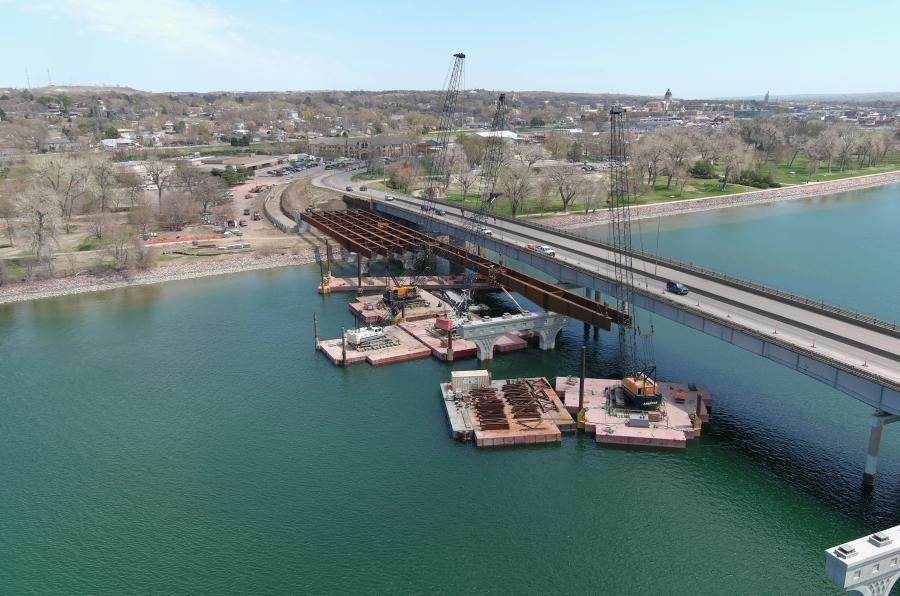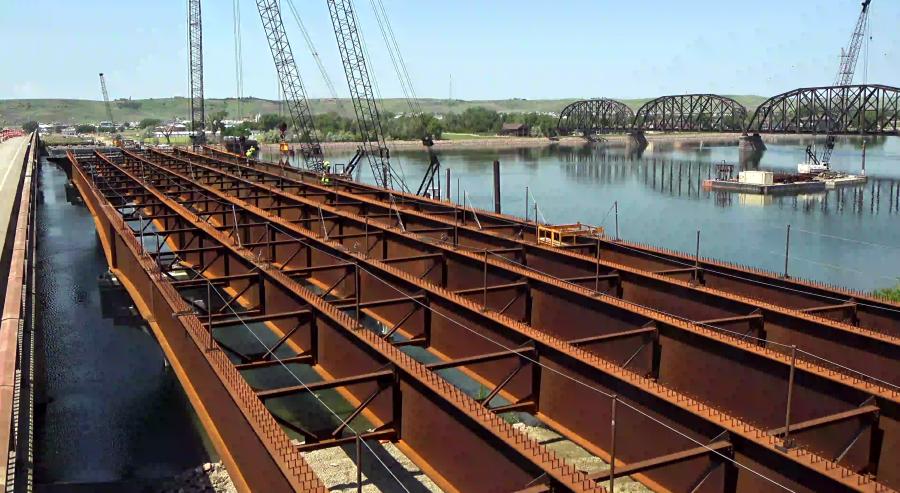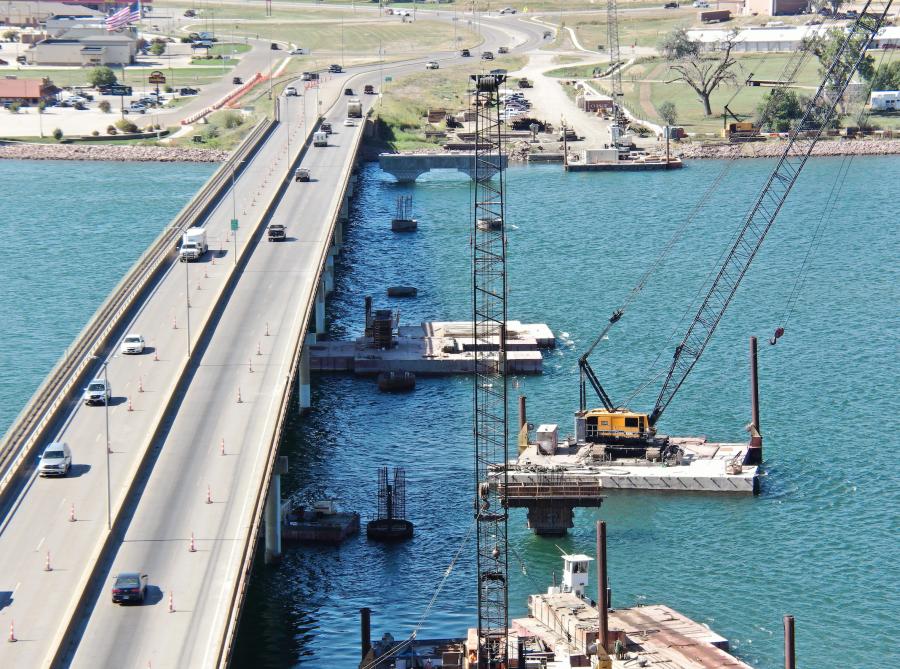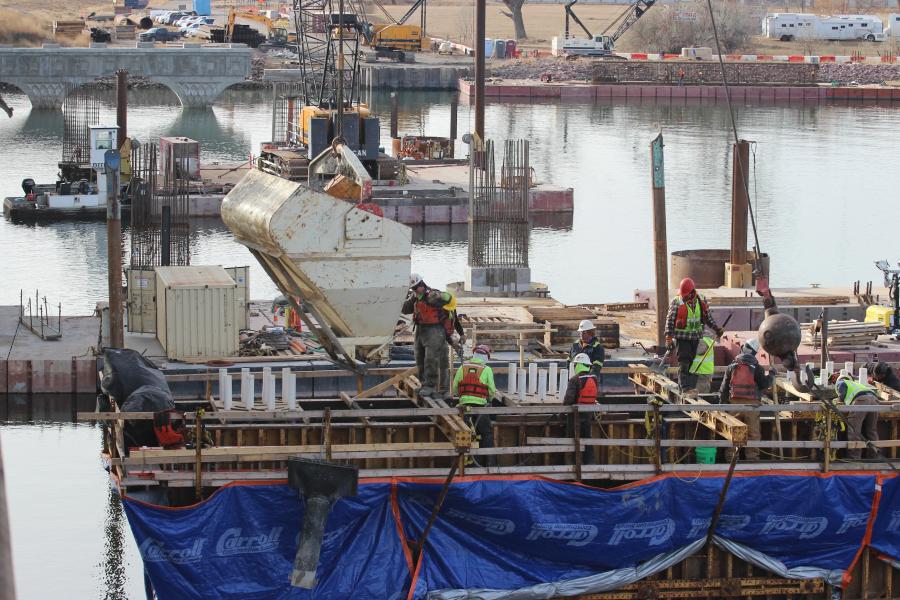Phase 1 construction on the Pierre-Fort Pierre Bridge project officially began in November 2020.
(SDDOT Pierre-Fort Pierre Bridge Project photo)
Having conquered demanding underwater substructure work, construction crews in South Dakota continue making progress on the $50 million Pierre-Fort Pierre Bridge project — bidding farewell to an iconic structure that's outlived its usefulness.
"While the John C. Waldron Memorial Bridge still stands, it's critical that the structure be replaced," said Dean VanDeWiele, Pierre area engineer of South Dakota Department of Transportation (SDDOT). "The bridge was opened in 1962, and is showing signs of deterioration, which can cause a variety of issues."
The structure carries U.S. Highways 14 and 83, along with S.D. Highway 34, and is a crossing point over the Missouri River between Fort Pierre and Pierre.
"Residents and visitors to Pierre and Fort Pierre use the bridge, often several times a day for work; to travel between the two communities; to transport agricultural and other products; for tourism and recreation; and to travel across the state of South Dakota," said VanDeWiele.
In 2016, SDDOT performed a bridge replacement study, with intentions of gathering more information to justify a structure replacement. After years of studying and planning, SDDOT decided to move forward with building a new bridge.
"Between Pierre and Fort Pierre, the Missouri River is a half mile to a mile wide," said VanDeWiele. "The two towns remained seasonally isolated until the railroad bridge, constructed in 1907, and the first highway bridge, constructed in 1926, joined the two towns. Prior to the bridges, methods of crossing the river depended on the season and the depth of the water that varied by season. In November or December, the river would freeze over to sufficient depth to create an ice bridge. When the ice broke up in March or April, various boats, ranging from rowboats to steam ferry boats, were used to move people, livestock and products across the river from 1876 until 1926."
Decades later, the existing bridge was constructed as a four-lane structure built from steel girders with a steel deck. The bridge has a Jersey‑style center divider and a sidewalk on the downstream side. The bridge features a vertical curve to achieve the required clearance above the river. In 2002, the standing bridge was dedicated to World War II hero Lt. Cmdr. John C. Waldon.
Phase 1 construction on the Pierre-Fort Pierre Bridge project officially began in November 2020. Crews have been working on the replacement bridge throughout the winter, in extremely frigid weather and on weekends, when necessary.
According to VanDeWiele, completing the underwater substructure work eliminated dealing with variable water depths and having to schedule work accordingly. Roadway approach work will carry through the summer of 2023.
This spring, commuters experienced the installation of two-way traffic in the eastbound lanes from the U.S. Highway 14/83 junction in Fort Pierre to Charles Street in Pierre. Closure of the westbound lanes is necessary for construction of the new bridge superstructure, berms, concrete paving and intersection work.
In addition to the two-way traffic configuration, a 10-ft. width restriction will be in effect around the same time. Overwidth vehicles will be directed around the Oahe Dam utilizing S.D. Highway 1806, S.D. Highway 204 and S.D. Highway 1804. The width restriction will remain in place through the entire 2023 construction season.
VanDeWiele stressed that river traffic will remain open during the entire construction process.
"Recreation on the Missouri River is not only important to the residents of Pierre and Fort Pierre, but also people from across the state and tourists. Jensen Construction Company, the prime contractor, has developed a river traffic control plan to keep boats away from the work zone and keep the public and construction employees safe.
"Jensen Construction Company is a heavy highway contractor with a primary emphasis on bridge construction. Jensen has more than 100 years of experience ranging in services from bridge construction, railroads, wind tower foundation and marine work. Jensen has completed jobs throughout the central United States with work primarily in the public sector, and is committed to building quality, design-bid-build projects that will exceed expectations and be done in a safe and efficient manner."
There are, however, numerous challenges on the project.
"The river fluctuates up and down approximately four feet every day," said VanDeWiele. "Also, the current bridge is only 10 feet away from construction of the new bridge, resulting in limited space to build the roadway on the ends of the bridge."
Crews are currently focused on erecting the structural steel girders and constructing the Fort Pierre-side abutment. Intersection work will soon start at the Highway 14/83 junction, as well as work on the mechanically stabilizing earth retaining walls for the Pierre-side abutment.
Twelve drilled shafts have already been constructed, and considerable work has been performed on the Pierre-side abutment. In addition, six bridge bents have been built, which includes columns, capitals, caps and pedestals.
An oversized steel casing, 13.5 ft. in diameter, was installed from a floating barge down through the water into the river bottom. A permanent 10-ft. diameter steel casing was installed inside the oversized casing and allowed for the concrete to be placed inside the 10-ft. casing, eliminating concerns about fresh concrete being spilled into the river. "The permanent casings were approximately 49 feet long," said VanDeWiele. "They were installed into the bed of the river and turned into the shale, creating a solid foundation.
"The ‘shaft' was then excavated using an auger to drill deep into the shale below the river's bottom. This occurred in a two-step auguring process. Once the shaft was excavated and cleaned out, the steel reinforcing rebar was inserted into the drilled shaft. These cages were fabricated offshore and taken by barge and lowered into the drilled shaft using a crane on the barge. Special spacers were used to make sure the rebar didn't come into contact with the bottom or sides of the drilled shaft to ensure the rebar was completely encased by the concrete."
Upon final inspection of the placement of the rebar, concrete was then placed in the drilled shaft. A concrete pump was used to fill the drilled shafts with concrete. This was carried out by displacing the water in the drilled shaft with concrete using a tremie tube, a long pipe with a length greater than the depth of the drilled shaft.
"One end of the tremie was lowered to the bottom of the drilled shaft, and concrete was placed through the use of the tremie tube," said VanDeWiele. "Before starting to place the concrete, a foam ball was inserted into the top end of the tremie tube. Once the ball was in place, concrete was placed in the tremie tube above the ball. By the weight of the concrete on top of the ball, the ball was pushed down the tremie tube which acted as a squeegee pushing the water down and out the bottom of the tremie.
"When the ball exited the tremie's bottom, the concrete then quickly began to displace the water in the bottom of the shaft in an upward direction. The tremie remained embedded into the concrete by five feet or more and was lifted at the same rate that the concrete came up in the shaft until the tremie reached the top of the permanent casing."
Numerous testing procedures were used throughout the process to guarantee the highest quality in materials and to ensure the installation was correct. Each drilled shaft contains approximately 365 cu. yds. of concrete and nearly 65,000 lbs. of steel. The concrete obtained a strength of more than 4,500 lbs. per square inch.
VanDeWiele noted that a large amount of rock piles had to be built during construction. More than 1,100 18-in. diameter aggregate columns were placed under each of the berm footprints to help stabilize the soils and prevent settlement where the berms meet the structure. In review of the project soils, SDDOT geotechnical engineers implemented the aggregate columns into the design.
Regarding girder erection for the new Pierre-Fort Pierre Bridge, VanDeWiele said it's starting to stretch across the Missouri River.
"Work on the structural steel began the week of March 13, 2023. The six haunch girders were trucked to Pierre/Fort Pierre and lowered from atop the current bridge utilizing two cranes on barges and one along the Pierre-side shoreline. The girders were lowered onto the temporary ‘angel wing' support on the bent seven cap, secured and braced.
"Following the placement of the six haunch girders over the bent seven cap, crews have been working on the six span girders at the Pierre-side abutment. The first two span girders for the Pierre abutment were lowered from atop the current bridge using cranes. The remaining four girders were lifted from a trailer on the ground of the Pierre side of the project. Once each span girder at the abutment was lined up with the corresponding haunch girder over the bent seven cap, they were connected using a splice plate and high-strength bolts."
As far as excavation, with only 10 ft. of space between the two bridges, the new roadway alignment merges into the old alignment. Therefore, excavation is complicated by the need to construct the new alignment immediately adjacent to the old. Construction sequencing is being done such that traffic can be maintained and funneled through the construction area.
Approximately 36,355 cu. yds. of unclassified excavation and 34,267 cu. yds. of contractor-furnished borrow will be moved during construction. Heavy equipment at the site has included multiple cranes, barges and excavators. Main materials include concrete, reinforcing steel, steel pile, structural steel and rock.
It's anticipated the new bridge will be open in the summer of 2024. Removing the existing bridge and plaza work under each abutment will then follow.
"In order to build a structure of this magnitude, there's a tremendous amount of communication, meetings and logistical discussions between SDDOT, contractor, designers, industry suppliers and experts, along with local governments and the Federal Highway Administration," said VanDeWiele, who added it's rewarding to see work continuing on such an important project.
"As the public is now able to see the work being completed above the water, there is a general excitement watching this project come to fruition. Every week brings a change. This will be further enhanced with 2023 grading, paving, signal work and bridge deck construction." CEG
Today's top stories

























